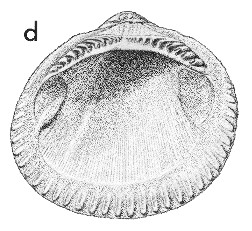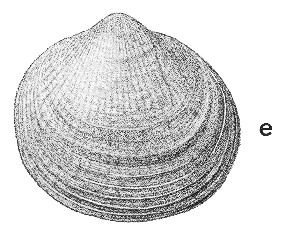
Revised descriptions of New Zealand Cenozoic Mollusca from Beu and Maxwell (1990)

 | Revised descriptions of New Zealand Cenozoic Mollusca from Beu and Maxwell (1990) | 
|
  (Pl. 32d): holotype (left valve), GS875, Q21/f6492, Manaia Beach, South Taranaki, Waipipian (TM4164, GNS) |
  (Pl. 32e): holotype (left valve), GS875, Q21/f6492, Manaia Beach, South Taranaki, Waipipian (TM4164, GNS) |
Beu & Maxwell (1990): Chapter 14; p. 275; pl. 32 d,e.
Synonymy: Glycymeris manaiaensis Marwick 1923, p. 72; Glycymeris (Manaia) manaiaensis
Type species of Manaia Finlay & Marwick, 1937
Classification: Glycymerididae: Glycymeridinae
Description: Moderate-sized for genus (48-62 mm high), markedly longer than high, with low umbo, weak external sculpture, and no ligamental chevron grooves, almost evenly oval but slightly oblique postero-ventrally. Sculpture of about 35-38 extremely low, wide radial costae separated by very shallow, widely spaced, radial grooves, each costa with several very low, indistinct radial threads on its surface; costae are reasonably distinct on most specimens near umbo, but absent from anterior and posterior ends, and fade out before ventral margin of most specimens. Commarginal sculpture of weak growth ridges only. Interior ventral margin strongly and deeply crenulate. Ligamental area narrowly triangular, smooth except for weak tracks of former hinge teeth. Hinge narrow, with numerous similar, outwardly concave teeth on each side, teeth obliterated in centre by downward growth of ligamental area.
Comparison: Glycymerita manaiaensis is the last in a group of species (subgenus G. (Manaia)) with weak ligamental chevrons (in early species) or no ligamental grooves at all (in later species); the common Miocene species G. huttoni, G. robusta, and G. hurupiensis are more inflated, much less regularly oval, and have a prominent radial fold on the posterodorsal area that is absent from G. manaiaensis. G. kaawaensis (Opoitian, Kaawa Creek, South Auckland) is intermediate between G. hurupiensis and G. manaiaensis, and not all specimens can be distinguished from G. manaiaensis.
Although previously classed as a subgenus of Glycymeris, Manaia seems to be more closely related to Glycymerita, and Beu & Maxwell (1990) classified it as a subgenus of the latter taxon.
Distribution: Waipipian-early Nukumaruan; Manaia Beach, South Taranaki, Waipipian (type); common in shallow-water, near-shore shellbeds and sandstone along the South Taranaki coast, in the Mangahao area of northern Wairarapa, and in North Canterbury. Less commonly found in Pliocene rocks throughout southern Taranaki-Wanganui, southern Hawke's Bay-northern Wairarapa, the Awatere Valley in Marlborough, North Canterbury, and Westland. Previously regarded as an index of "Waitotaran" (= Waipipian and Mangapanian) age, but G. manaiaensis is common in early Nukumaruan rocks in North Canterbury (notably at Motunau Beach, with common Chlamys patagonica delicatula and Pelicaria rugosa) and in northern Wairarapa.
Cite this publication as: "A.G. Beu and J.I. Raine (2009). Revised
descriptions of New Zealand Cenozoic Mollusca from Beu and Maxwell (1990). GNS
Science miscellaneous series no. 27."
© GNS Science, 2009
ISBN
978-0-478-19705-1
ISSN 1177-2441
(Included with a PDF facsimile file
copy of New Zealand Geological Survey Paleontological Bulletin 58 in CD version
from: Publications Officer, GNS Science, P.O. Box 30368 Lower Hutt, New
Zealand)